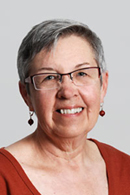I promised some more posts about "Fiberlandia", the 2015 SAQA Conference in Portland, Oregon last month, so let me begin with that. :-)
Fiberlandia Highlights I: The Keynotes
 |
| Namita Gupta Wiggers |
The first of four keynote speakers at the Conference,
Namita Gupta Wiggers is a curator, art historian, museum educator, ethnographer, design researcher, writer, teacher and studio art jeweller.
She opened our Conference on Friday, May 1, with her topic,
Quilt: A rose by any other name would smell as sweet...
A rather cryptic title...so she gave a bit of background. Her example, "
Object Focus: The Bowl", was a project undertaken at the
Museum of Contemporary Craft in 2013, which explored the bowl as an example of an every-day object, an iconic and archetypal form from daily life and the challenge it is when a museum undertakes to present, analyze and consider such a form in the context of its value, its cultural history.
Ms. Wiggers posited that there must be a different way to talk about craft-based
work. How does the quilt 'inhabit' the work that goes into its creation? Is there an archetypal form for the quilt, much like "the white cube" in contemporary art?
She then referred to
Martha Buskirk's book,
The Contingent Object of Contemporary Art, in which it is suggested that the fracturing of artistic genres that began particularly in the mid-nineteen-sixties, when artists like
Jackson Pollock "[created] paintings that destroyed painting itself", and
Robert Rauschenberg ",,,used paint as a [construction] material like any other."
What evolved was the notion that the physical act of
making -- i.e., the maker's
process -- is as important as the end-product itself. "
A" quilt becomes "
the" quilt.
Ms. Wiggers then explored this shift from materials to content, taking as her frame-work the essay, "Thirteen Ways of Looking at a Blackbird", by
Thomas McEvilley, and addressing the quilt specifically.
At this point, her presentation became rather complex and my notes, rather sketchy! Here are the points I noted:
- The power of the art quilt to break the picture plane -- materials, layers, scale, temporal duration;
- The art quilt's context: where does the quilt move?
- It's heritage -- which is complicated;
- Time -- the maker's personal history;
- Formal properties; e.g., stitching;
- Attitudinal gestures: wit, irony, parody;
- The viewers' biological/physiological response to the piece; and
- What informs the maker's process?
- Workshops? (e.g., Dorothy Caldwell on mark-making)
- NOTE: Ms. Caldwell is one of the faculty at MAIWA Textile Symposium 2015 (Vancouver, B.C), and will be giving both a lecture and a 5-day workshop.
- Self-critique?
- Self-reflexivity?
- Studio/community?
- Quilt artists mentioned:
 |
| Maria Shell |
Our second keynote speaker,
Maria Shell, turned the ostensibly dry topic of preparing proposals for shows and applying for artist's residencies and/or grants into an interesting, informative and very human journey. She was so popular that she reproduced the text -- and photos -- of her talk on her blog, and will be presenting a webinar for SAQA members later this month (it will be recorded for those who cannot attend live). Rather than summarize her talk as I did with Ms. Wiggers, I refer you to Ms. Shell's
blog post, and to
the registration page for the SAQA Webinar. Enjoy!
 |
Charlotte Bird
in her studio |
Our last two keynote speakers were a pair: Beth Smith and
Charlotte Bird. Beth is the Executive Director of
Visions Art Museum: Contemporary Quilts and Textiles, and has a background as a curator, juror, lecturer, artist and author of articles on quilts and textiles. Charlotte is the Past President of the Board of Directors of the Visions Art Museum, and has curated the
Quilt Visions Biennial exhibitions since 2008. She exhibits widely, and textile is but one medium in which she works.
Working together, Beth and Charlotte gave us a lively overview of all that goes into the production of the biennial exhibition, from preparing for the Call for Entry through the jury process to the hanging of the show. The care and attention to every detail took my breath away. Followiing their talk, Beth and Charlotte entertained questions about entering the Biennial exhibitions, about shipping quilts and the like. Here are some of the quick notes I made during the question period:
- Do you use a service to process your Calls for Entry?
- Visions employs ArtCall to process juried calls for entry for their exhibitions (as does SAQA and many other art quilt organizations).
- Shipping tip: be sure to include a return shipping label and your contract with your item!
- Herewith followed the discussion about return shipping to a U.S. venue from within the U.S. versus return shipping to a foreign country, which is not possible if the non-U.S. artist wants to use the Postal Service in her/his country.
- A swimming pool noodle is a handy 'core' around which to roll a quilt for shipping.
- For hanging?
- Some use a flat rod; others, wood, aluminum or plexi-glass.
And the Big Question -- saved for the end: what's the theme and who are the jurors for Quilt Visions 2016?
- Theme: Break Out!
- Jury members:
I hope you enjoyed this overview of the keynotes at the Portland Conference. Next up? Two of the four break-out sessions -- featuring
Sue Reno and
Lyric Kinnard. Stay tuned!












